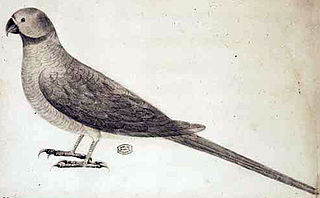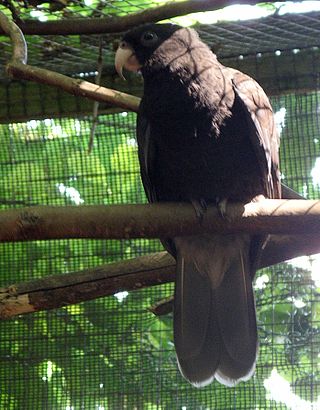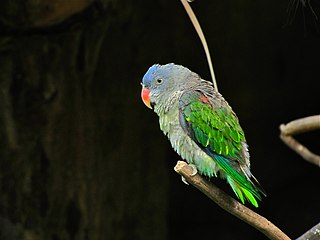
The rose-ringed parakeet, also known as the ringneck parrot or the Kramer parrot, is a medium-sized parrot in the genus Psittacula, of the family Psittacidae. It has disjunct native ranges in Africa and the Indian Subcontinent, and is now introduced into many other parts of the world where feral populations have established themselves and are bred for the exotic pet trade.

Newton's parakeet, also known as the Rodrigues parakeet or Rodrigues ring-necked parakeet, is an extinct species of parrot that was endemic to the Mascarene island of Rodrigues in the western Indian Ocean. Several of its features diverged from related species, indicating long-term isolation on Rodrigues and subsequent adaptation. The rose-ringed parakeet of the same genus is a close relative and probable ancestor. Newton's parakeet may itself have been ancestral to the endemic parakeets of nearby Mauritius and Réunion.

The plum-headed parakeet is a species of parakeet in the family Psittacidae. It is endemic to the Indian Subcontinent and was once thought to be conspecific with the blossom-headed parakeet before being elevated to a full species. Plum-headed parakeets are found in flocks, the males having a pinkish purple head and the females, a grey head. They fly swiftly with twists and turns accompanied by their distinctive calls.

The blossom-headed parakeet is a parrot in the family Psittaculidae.

The Alexandrine parakeet, also known as the Alexandrine parrot, is a medium-sized parrot in the genus Psittacula of the family Psittaculidae, native to South Asia and Southeast Asia. It is named after Alexander the Great, who transported numerous birds from Punjab to various European and Mediterranean countries and regions, where they were prized by the royalty, nobility and warlords.

The slaty-headed parakeet is the only psittacid species to exhibit altitudinal migration. The species' range extends from Pakistan, to Western Himalayas in India through Nepal and Bhutan and up to the Eastern Himalayas in the northeastern Indian state of Arunachal Pradesh. They descend to the valleys in winter, approximately during the last week of October.

The echo parakeet is a species of parrot endemic to the Mascarene Islands of Mauritius and formerly Réunion. It is the only living native parrot of the Mascarene Islands; all others have become extinct due to human activity. Two subspecies have been recognised, the extinct Réunion parakeet and the living echo parakeet, sometimes known as the Mauritius parakeet. The relationship between the two populations was historically unclear, but a 2015 DNA study determined them to be subspecies of the same species by comparing the DNA of echo parakeets with a single skin thought to be from a Réunion parakeet, but it has also been suggested they did not constitute different subspecies. As it was named first, the binomial name of the Réunion parakeet is used for the species; the Réunion subspecies thereby became P. eques eques, while the Mauritius subspecies became P. eques echo. Their closest relative was the extinct Newton's parakeet of Rodrigues, and the three are grouped among the subspecies of the rose-ringed parakeet of Asia and Africa.

The Nicobar parakeet, also known as the Blyth's parakeet, is a parrot in the genus Psittacula, endemic to the Nicobar Islands of the Indian Ocean. It is one of the largest parakeets, measuring 56 to 60 cm from the top of the head to the tip of the tail and weighing about 224 g.

The vasa parrots that form the genus Coracopsis are four species of parrot in the Old World parrot family Psittaculidae that are endemic to Madagascar and other islands in the western Indian Ocean. Some taxonomists formerly placed the species in the genus in Mascarinus, but this is now thought to be based on the results of a heavily flawed, later-debunked genetic study.

The Seychelles parakeet or Seychelles Island parrot is an extinct species of parrot that was endemic to the Seychelles in the Indian Ocean. It was scientifically named Palaeornis wardi by the British ornithologist Edward Newton in 1867, and the specific name honours the British civil commissioner Swinburne Ward who procured the specimens that formed the basis for the description. It was found on the islands of Mahé, Silhouette, and possibly Praslin. Ten skin specimens exist today, but no skeletons. Though the species was later moved to the genus Psittacula, genetic studies have led some researchers to suggest it should belong in a reinstated Palaeornis along with the closely related Alexandrine parakeet (P. eupatria) of Asia.

Psittaculini is a tribe of parrots of the family Psittaculidae. The subdivisions within the tribe are controversial.

The Mascarene parrot or mascarin is an extinct species of parrot that was endemic to the Mascarene island of Réunion in the western Indian Ocean. The taxonomic relationships of this species have been subject to debate; it has historically been grouped with either the Psittaculini parrots or the vasa parrots, with the latest genetic study favouring the former group.

The Rodrigues parrot or Leguat's parrot is an extinct species of parrot that was endemic to the Mascarene island of Rodrigues. The species is known from subfossil bones and from mentions in contemporary accounts. It is unclear to which other species it is most closely related, but it is classified as a member of the tribe Psittaculini, along with other Mascarene parrots. The Rodrigues parrot bore similarities to the broad-billed parrot of Mauritius, and may have been related. Two additional species have been assigned to its genus, based on descriptions of parrots from the other Mascarene islands, but their identities and validity have been debated.

Tanygnathus is a genus of parrots in the Psittaculini tribe, of the superfamily of Psittacoidea.

Psittinus is a genus of parrot in the family Psittaculidae. It was formerly considered to include a single species, the blue-rumped parrot, but the Simeulue parrot was split as a distinct species by the IOC in 2021. A 2019 genetic analysis found that the genus Psittacula is paraphyletic with respect to Psittinus, indicating that Psittacula may have to be split into different genera in order to maintain Psittinus as a distinct genus.
The intermediate parakeet or Rothschild's parakeet was a kind of parakeet reported from the sub-Himalayan region of India and was described on the basis of about seven undated specimens. Similar individuals have been noted in captivity and the type specimen is now believed to be a hybrid between Psittacula himalayana and Psittacula cyanocephala. More recent captive specimens that appeared similar were found to be hybrids produced by crosses between Psittacula krameri and Psittacula cyanocephala. An analysis of the characters of the specimens suggests that the originally described P. intermedia was a hybrid between P. cyanocephala x P. himalayana.

The Mascarene grey parakeet, Mauritius grey parrot, or Thirioux's grey parrot, is an extinct species of parrot which was endemic to the Mascarene Islands of Mauritius and Réunion in the western Indian Ocean. It has been classified as a member of the tribe Psittaculini, along with other parrots from the Islands.

The parrot subfamily Psittaculinae consists of three tribes: the Polytelini with three genera, the Psittaculini or Asian psittacines, and the pygmy parrots of the Micropsittini tribe.

Palaeornis, the epauletted parakeets is a genus of birds named for the red markings on their upper wings resembling epaulettes. Formerly included in the genus Psittacula, this group of birds comprises two species, only one of which is still extant. The genus name was formerly deprecated until it was revived in 2019 by a molecular study on the taxonomics of the genus Psittacula, splitting it into 10 genera, which has been accepted by the IUCN Redlist.


















